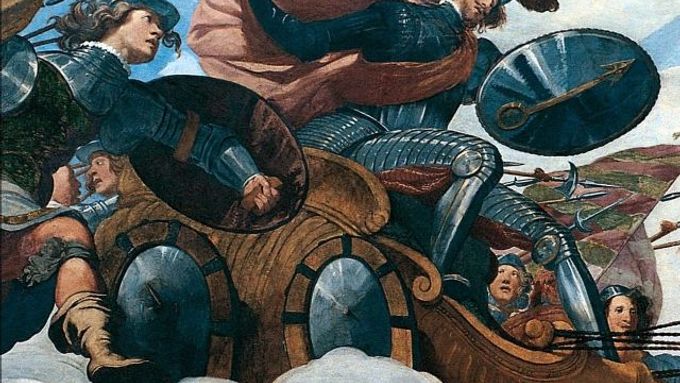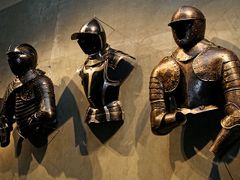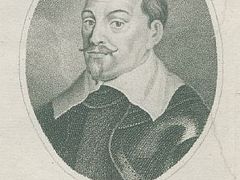Prague - Cultural event of the year, that´s how the new major exhibition called Albrecht of Waldstein and His Era, which opened in Prague´s Waldstein (yes, the same guy) Riding School last week, is being described left and right. So what´s the fuss all about?
Albrecht of Waldstein, also known as Wallenstein or Valdštejn, was undoubtedly one of the most influential figures in the 17th century Central Europe.
A Czech nobleman, politician and an imperial military commander, whose exploits were literally shaping history in the heady days (well, years, really) of the Thirty Years War, used to be depicted in a rather simplistic way in the post-war history schoolbooks.
Reading those, one might be forgiven for thinking that the name Waldstein is synonymous with bloodthirsty, greedy and treacherous men of no principles. The exhibition´s authors took it upon themselves to present this undeniably complex figure in a rather new perspective.
Items from all over
The exhibition opened on November 15th in the Waldstein Riding School, part of the sprawling Waldstein Palace, which today houses the Senate, upper house of the Czech parliament, and will last until March 2nd, 2008.
There is a total of 727 items on display, some of which have never been publicly exhibited. Many items have been loaned from Italy, Austria, Germany, the Netherlands, Denmark and Hungary. In all of these countries Albrecht lived, worked and/or fought against the emperor´s enemies with the help of his private army.
The exhibition is a result of a joint work of the National Museum and the Military History Institute. The third organizer was the Czech Senate.
Military scenes picturing Albrecht of Waldstein are a frequent motif of paintings that are featured in the exhibition.
"There are, for example, two great paintings by a Flemish painter, Pieter Snayers; one called The Siege of Prachatice and the other The Battle of the White Mountain, the most precious paintings of their kind that we have here," says the main exhibition curator Eliška Fučíková.

Infobox
Practical Tips
- Visit the exhibition on Thursday after your work it stays open until 9 p.m.
- Visit the exhibition every first Wednesday in a month the entrance is free from 3 to 8 pm.
- Buy a guidebook the legends describing the exhibition items are rather brief. You will enjoy the exhibition much more with the guidebook, which costs only 370 CZK.
- Take your kids with you. There are games prepared for them and there is also a place next to the Cafe where they can play while you are visiting the exhibition. You can buy a CD ROM for them to take home, which has a spoken guide and a computer game about Albrecht of Waldstein.
- Attend presentations organized for the exhibition on Tuesdays starting at 5 p.m. in Zaháňský Hall of the Waldstein Palace.
Unique horoscope
"A unique feature of the exhibition is Waldstein´s horoscope, which is very extensive, and outlines Waldstein's life day by day. It was discovered just recently in the Kopidlno castle," adds another curator Ladislav Čepička.
Waldstein´s horoscope was made by an unknown astrologer and even the purpose of its creation remains a mystery.
In Waldstein´s times horoscopes of prominent figures were top secret and treated as strategic documents. If fallen into the hands of the person´s enemies, it could betray confidential information about his life.
Swords and a velvet saddle
Apart from shedding light on Waldstein's own life, the exhibition aims to show what the life was like in general in that period.
Various furniture, clothing, toys, jewelry and glass jugs are thus displayed along with plenty of other items from Waldstein's days.
Albrecht of Waldstein was a successful generalissimus with a history of distinguished service in the Imperial Army, which explains why many of the exhibited items are military artifacts such as the cutlasses and swords that had once belonged to the Thirty Years War generals.
There is also Waldstein's festive riding saddle made of red velvet and light leather cannon loaned from a Danish collection.
Just like Bill Gates
The only such exhibition of this size dedicated to Albrecht of Waldstein in the past was held in 1934 on the 300th anniversary of his death in Cheb (known as Eger in German).
The exhibition organizers maintain that the perception of Waldstein has radically changed since that time.
"He was not only an excellent military commander but also a patron of arts, excellent financier and a builder, securing large estates and possessions," says Ladislav Čepička from the Military History Institute.
"Had Albrecht of Waldstein lived today, he would be someone like Bill Gates. Coming from a meager background he became a man of power and ambition," says Eliška Fučíková.
Organizers are, however, aware he was a much more complex figure.
"Waldstein was an enormously controversial figure. The exhibition attempts not to depict him only in black and white, nor to judge him. We want to present the entire era and also show the viewers it was not only the age of darkness," adds the Senate Speaker Přemysl Sobotka.
Life after life
Albrecht of Waldstein was a very ambitious man and it was precisely his untamed ambition that ultimately got him. Austrian Emperor Ferdinand II grew wary of his powers and wealth and had him assassinated in 1634 by Scottish and Irish officers.
The exhibition is divided into four parts. Each of them represents a period of Waldstein´s life, while the last one is dedicated to his cult, which grew posthumously, especially in the 19th century. Friedrich Schiller made him a central subject of his epic masterpiece in 1799.
The exhibition is accompanied by two publications: a guidebook and an extensive 624-page monograph called "Albrecht Of Waldstein, Inter Arma Silent Musae" - When the weapons speak, the muses fall silent.
The exhibition also gives space to children visitors. There is a whole range of tasks prepared for them, and if they succeed, they will be awarded.
If they don´t, they will get a pillory or a wooden donkey, symbols of dishonor and disgrace for the soldiers of Waldstein´s army. Now, that´s how you straighten out a wayward kid.








